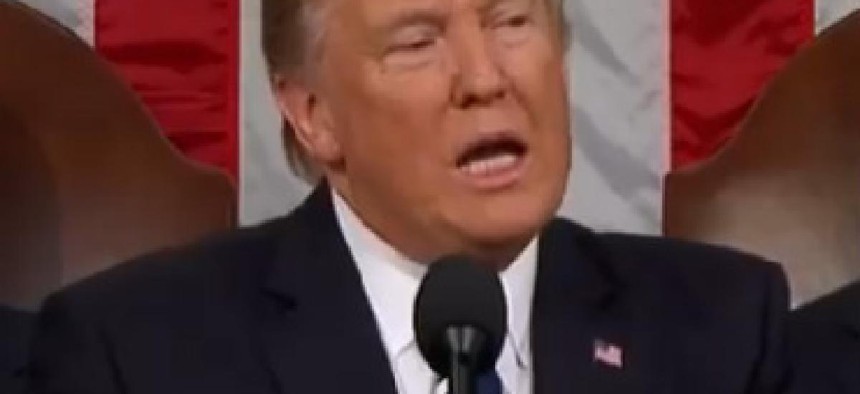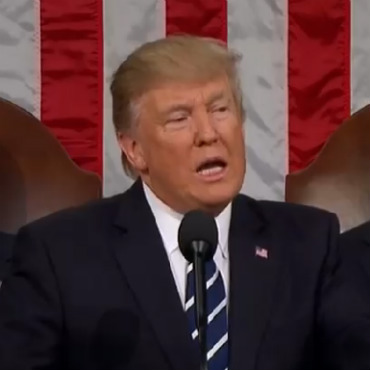Trump's 2018 budget plan hacks civilian spending for defense, homeland

As promised, a budget blueprint from the Trump administration prioritizes military and homeland security spending, and pays for increases with dramatic cuts to civilian agencies.

President Trump's "skinny budget" for 2018 slashes spending at civilian agencies to support big increases in defense and homeland security.
The 2018 "budget blueprint" released March 16 by the Trump administration makes good on a pledge to hike defense and homeland security spending, and dramatically reduce outlays for foreign assistance and civilian agencies, with many coming in for double-digit percentage point cuts.
President Donald Trump's plan raises the defense budget by $54 million, and cuts the same amount from the civilian side of the ledger. The Department of State is in for a $10.9 billion cut, a 28.7 percent reduction over its 2017 budget, based on funding levels in the current continuing resolution. The Department of Labor and the Department of Agriculture both come in for 20 percent cuts. The Departments of Education, Commerce, Health and Human Services, Interior and Transportation are all targeted for double-digit percentage reductions over 2017 levels.
Additionally, the budget blueprint zeroes out 19 small independent agencies.
The document was received coolly at best, by Trump's Republican allies on Capitol Hill.
Rep. Diane Black (R-Tenn.), chair of the House Budget Committee said, "I appreciate the White House's submission on how we can be better stewards of taxpayer dollars and strengthen our national security," and added, "We look forward to continuing our discussions with the White House, with our committee members and with the full House as we work towards introducing the Fiscal Year 2018 budget."
Sen. Marco Rubio (R-Fla.) was blunter. "The administration's budget isn't going to be the budget. We do the budget here. The administration makes recommendations, but Congress does budgets."
Democrats were highly critical. Sen. Pat Leahy (D-Vt.), vice chairman of the Appropriations Committee, said, "Like some of the president's tweets, the Trump budget is a hasty list of appallingly unbalanced, shortsighted, politically driven priorities."
Federal employee advocates warned of layoffs under the plan. J. David Cox Sr., national president of the American Federation of Government Employees, said in a statement that, "The severity of the budget cuts proposed by President Trump could require mass layoffs of employees at federal departments and agencies, although the budget blueprint released by the White House does not detail how many federal employees could lose their jobs."
IT and Management
A brief management section previews Trump's coming management agenda, announcing a focus on "effectiveness, efficiency, cybersecurity, and accountability." While short on details, the Trump budget blueprint took aim at "governmentwide policies [that] often tie agencies' hands and keep managers from making commonsense decisions."
The document singled out IT, human resources and acquisition as areas due for a rethink.
"Despite years of efforts to improve these critical management processes, managers remain frustrated with hiring methodologies that do not consistently bring in top talent, acquisition approaches that are too cumbersome, and IT that is outdated by the time it is deployed," the document says.
Trump plans to "roll back low-value activities and let managers manage, while holding them accountable for finding ways to reduce the cost of agency operations."
Defense
The blueprint seeks $603 billion in base defense spending. While the proposal doesn't break down where that money will be spent, it aims to bolster America’s dominance in all domains, including cyberspace.
The request request represents a $54 billion increase over the 2018 cap mandated by the Budget Control Act, and a $19 billion increase over what the Obama administration had proposed for 2018, but it's short of the $640 billion that the chairmen of the House and Senate Armed Services committees say is needed to rebuild the military.
House Armed Services Committee Chairman Rep. Mac Thornberry (R-Texas) called the proposal inadequate. "We must complete this year's work by passing the appropriations bill and the supplemental request, and then in turn adopt a budget for next year that meets the needs of the nation’s national security."
His Senate counterpart, John McCain (R-Ariz.) said, "Mac Thornberry and I agree a defense budget of $640 billion in fiscal year 2018 and sustained increases for years to come are needed to rebuild our military, restore military readiness, and modernize our forces for the realities of 21st century warfare"
In addition to the proposed 2018 budget, the White House also announced a 2017 supplemental defense spending bill that includes an additional $25 billion in base spending and $5 billion more in Overseas Contingency Operations funding.
But, that request creates its own problems. Thornberry told reporters on March 8 that he expected the 2017 supplemental to be OCO and emergency funding in order to avoid having to re-legislate the 2017 spending bill.
"I have expected it to be OCO because everybody’s aware of the time frame we’re operating under, but, we can all be surprised," he said.
Homeland Security
The budget calls for $462 billion in non-defense discretionary spending. The Department of Homeland Security is the biggest winner that spending bucket, with a 6.8 percent increase to a total budget of $44 billion.
The White House listed cybersecurity among four management goals, and is looking to DHS as the center for new activity. The budget blueprint calls for $1.5 billion for DHS activities to shield federal networks and critical infrastructure from cyberattack.
"Cybersecurity will be funded through DHS and the Department of Defense," said presidential adviser Thomas Bossert in a March 15 speech at the Center for Strategic and International Studies.
Bossert said DHS would become a "quasi-shared service provider" for federal agency cybersecurity. He said that a large scale network modernization effort, perhaps costing $90 billion, is a more long-term and wouldn’t be reflected in the 2018 budget proposal.
Modernizing aging federal IT requires "more time and analysis" to tackle, he said, adding that details on IT modernization plans would be forthcoming.
The biggest increase is a $4.5 billion boost for programs to strengthen border security and the immigration system -- in other words the border wall and beefed up personnel and systems. The proposal includes $2.6 billion for the wall project, and $314 million for new immigration enforcement personnel. The Trump administration also announced plans to seek an additional $3 billion in additional funds for fiscal 2017 for immigration enforcement and initial steps to build the wall.
Mick Mulvaney, director of the Office of Management and Budget, said on CNN that it was still unclear what form the wall would take or what it would cost.
"We don't know the answer to that question because we haven't settled on construction types, we haven't settled on where we're going to start I think the funding provides for a couple of different pilot cases."
The budget also calls for $15 million to begin implementing mandatory nationwide use of the E-Verify Program, the internet-based system that businesses use to determine eligibility of new employees to work in the United States.
According to DHS, the Coast Guard would not take a significant cut under the proposal. But the White House is proposing some cuts to DHS. The budget proposes a $667 million cut to the Federal Emergency Management Agency’s state and local grant program, as well as an $80 million reduction in the Transportation Security Administration’s programs, including programs at railroad stations and bus terminals.
VA and other agencies
The Department of Veterans Affairs is also due for a $4.4 discretionary spending increase, a 6.6 percent budget increase over 2017. Some of that money is apparently targeted to tech. The blueprint includes plans to invest in IT to "improve the efficiency and efficacy of VA services," while providing "sufficient funding for sustainment, development, and modernization initiatives that would improve the quality of services provided to veterans and avoid the costs of maintaining outdated, inefficient systems."
While overall Treasury is due for a 4.4 percent cut, the blueprint promises gains in cybersecurity at the agency, which includes the IRS. The Trump administration says the budget, "strengthens cybersecurity by investing in a department-wide plan to strategically enhance existing security systems and preempt fragmentation of information technology management across the bureaus, positioning Treasury to anticipate and nimbly respond in the event of a cyberattack."
As noted by lawmakers, the budget is unlikely to pass in its present form, and more details will be forthcoming in a more complete submission. Even in that context, the Center for Budget and Policy Priorities noted that the Trump blueprint was shorter on detail than similar documents from prior administrations. Among other omissions, the Trump blueprint did not include data on non-discretionary spending, budget grand totals or economic assumptions.


